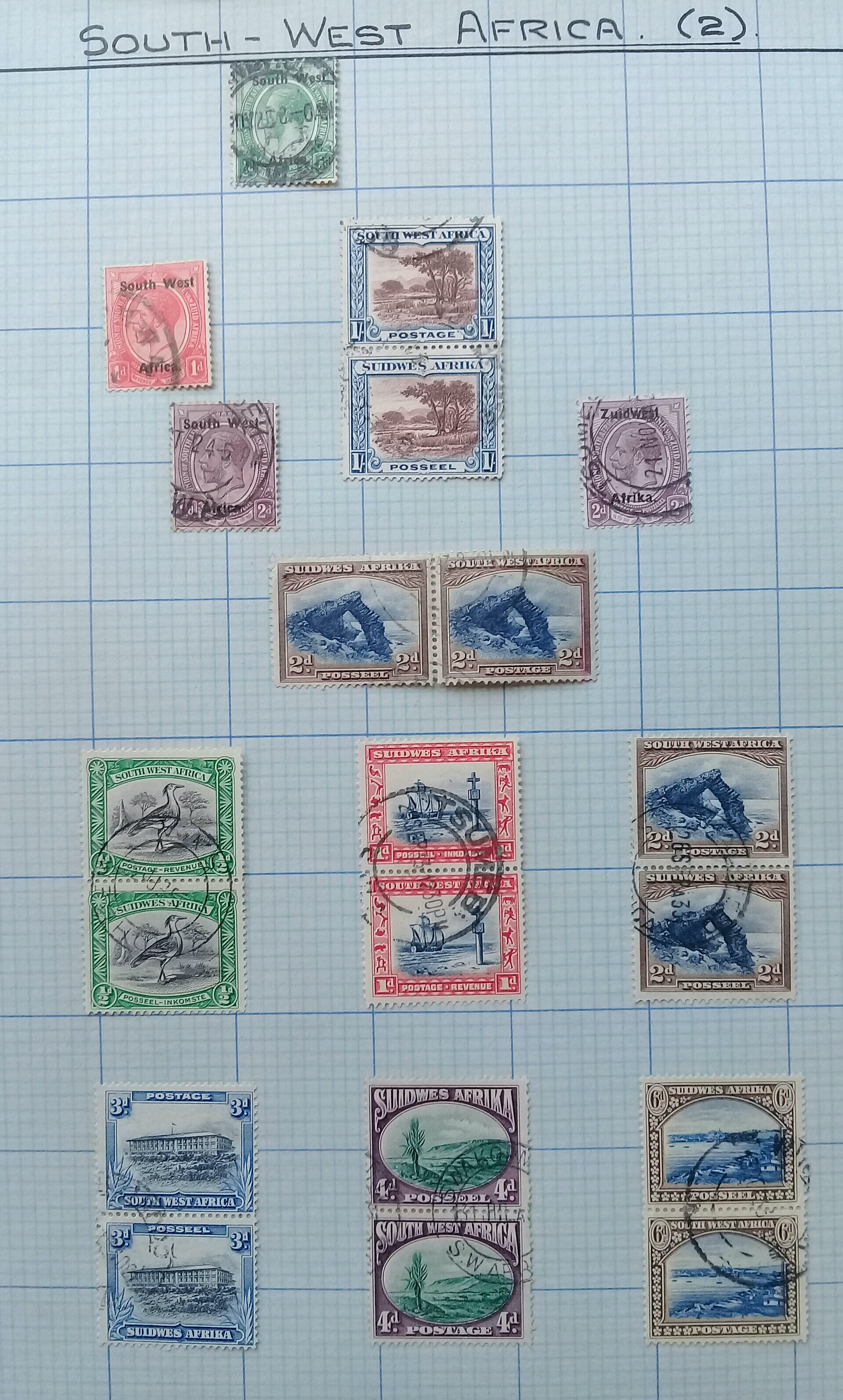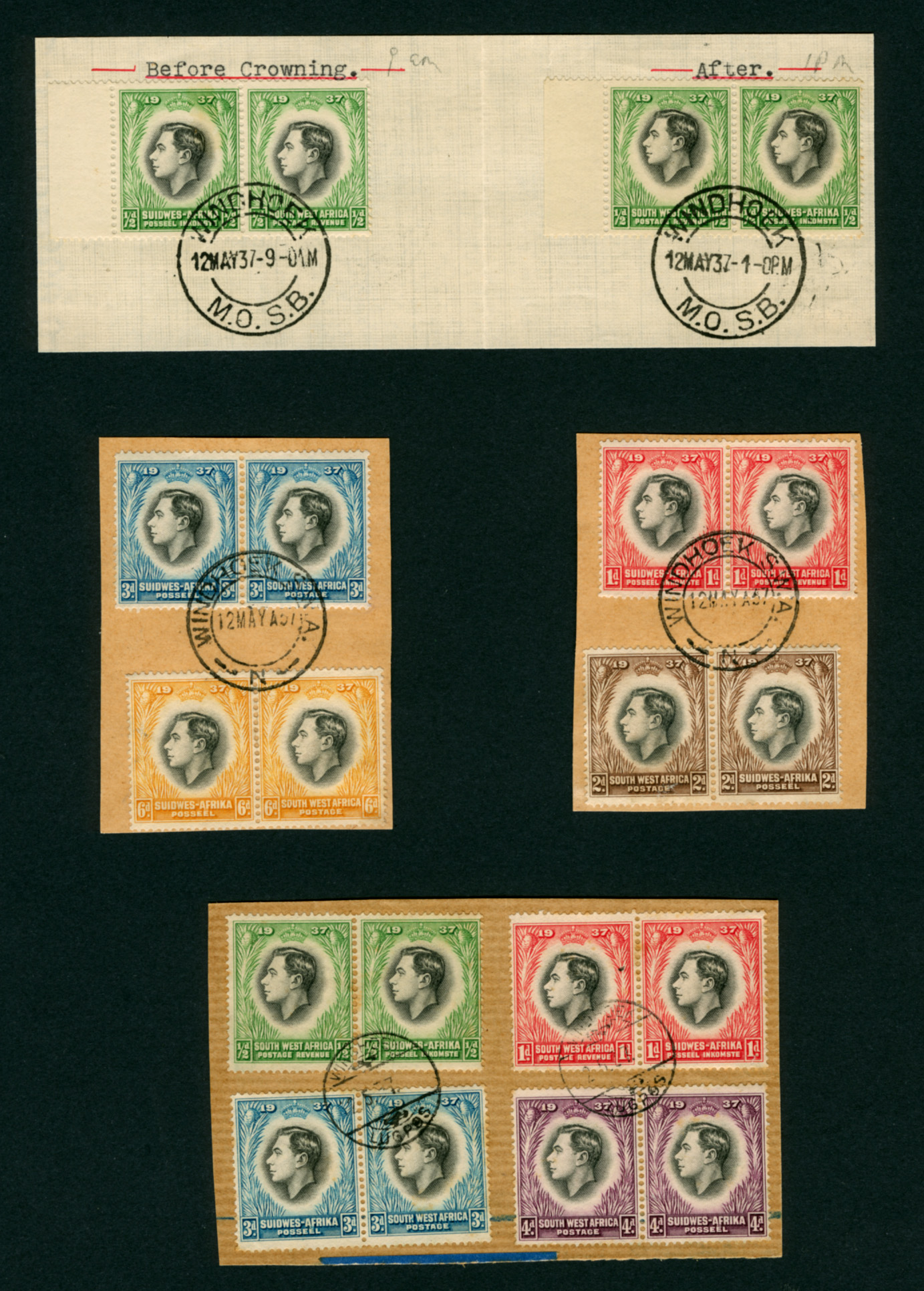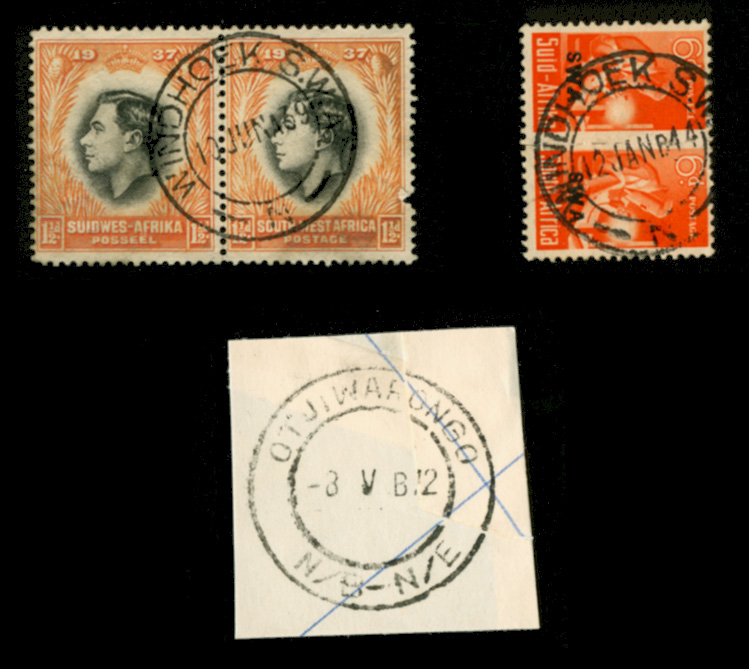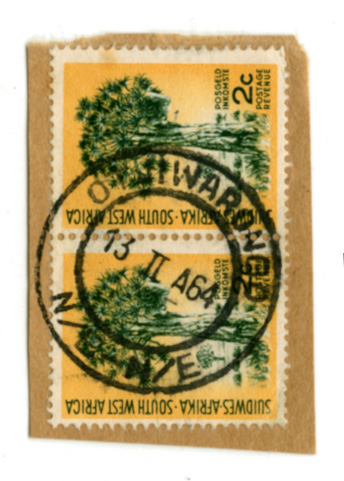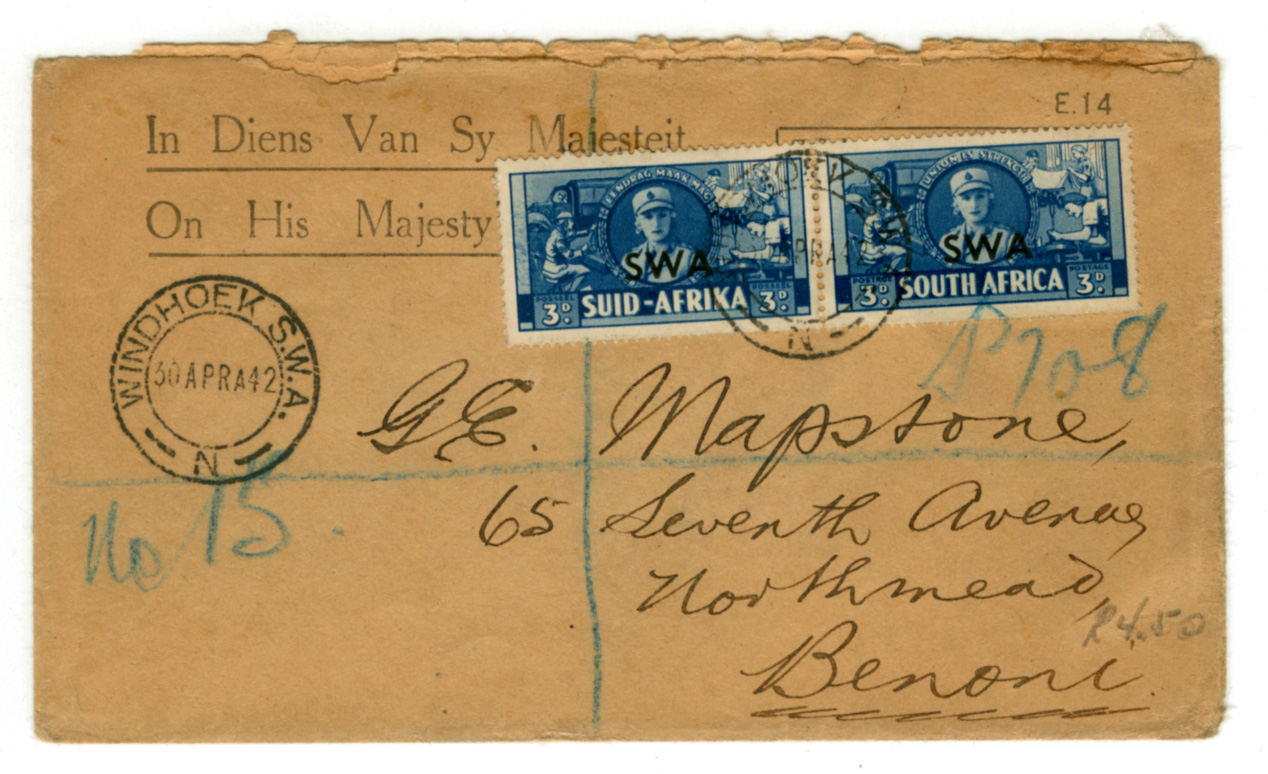South West Africa
Quote from Steve on September 24, 2021, 10:59 amThis is a good used starter for you or someone to expand on. There are some nice full and partial postmarks here, Tsumeb, Windoek and Walvis Bay. The latter was, of course, SA territory at that time and so strictly should not be included in a SWA collection. However, the fact that Walvis Bay is now a part of Namibia and no longer an exclave of South Africa shows that its history is truly that of Namibia. Indeed, in my SWA / Namibia Part 1- 4 displays I include Walvis Bay. There is no good reason not to!
You have two horizontal Pictorial pairs. Various stamp catalogues rate these more valuable / collectable than vertical pairs, of which you have more. This requirement is a result of SA and SWA being a bilingual country at that time with just two official languages, English and Afrikans. (German only became an official language in the 1980s!) As a result you were supposed to collect SA and SWA stamps in pairs that showed one each of English and Afrikaans. It was enforced to some extent by the way old printed stamp albums only reproduced the stamps as horizontal pairs on the album page and by catalogues that only gave prices for horizontal pairs. If, however, you are a postmark collector, like me, you generally won't be so fussy as to ignore a beautiful iful strike on a vertical pair.
I like GSWA (German), SWA and Namibia and will be posting Part 2 of the SWA (World War 1 and SA Occupation) on the SAPC site shortly. Part 3 of my SWA display contains some material similar to that shown here ie. the 1931 Definitives up to 20/- used. I apologise if I sound dismissive. We all have to start somewhere. What you have submitted are basic starters that research, time and some expense could turn into a more serious collection. What you have submitted is a useful way for beginners and laymen to be introduced to the wonderful world of southern African philately. Thanks for taking the trouble to post this.
This is a good used starter for you or someone to expand on. There are some nice full and partial postmarks here, Tsumeb, Windoek and Walvis Bay. The latter was, of course, SA territory at that time and so strictly should not be included in a SWA collection. However, the fact that Walvis Bay is now a part of Namibia and no longer an exclave of South Africa shows that its history is truly that of Namibia. Indeed, in my SWA / Namibia Part 1- 4 displays I include Walvis Bay. There is no good reason not to!
You have two horizontal Pictorial pairs. Various stamp catalogues rate these more valuable / collectable than vertical pairs, of which you have more. This requirement is a result of SA and SWA being a bilingual country at that time with just two official languages, English and Afrikans. (German only became an official language in the 1980s!) As a result you were supposed to collect SA and SWA stamps in pairs that showed one each of English and Afrikaans. It was enforced to some extent by the way old printed stamp albums only reproduced the stamps as horizontal pairs on the album page and by catalogues that only gave prices for horizontal pairs. If, however, you are a postmark collector, like me, you generally won't be so fussy as to ignore a beautiful iful strike on a vertical pair.
I like GSWA (German), SWA and Namibia and will be posting Part 2 of the SWA (World War 1 and SA Occupation) on the SAPC site shortly. Part 3 of my SWA display contains some material similar to that shown here ie. the 1931 Definitives up to 20/- used. I apologise if I sound dismissive. We all have to start somewhere. What you have submitted are basic starters that research, time and some expense could turn into a more serious collection. What you have submitted is a useful way for beginners and laymen to be introduced to the wonderful world of southern African philately. Thanks for taking the trouble to post this.
Quote from Steve on June 2, 2024, 9:27 amI recently found the South West Africa postal history items below. They show an interesting aspect of the Coronation of King George V stamps of 12th May 1937 and the introduction of SA-style segregation, (not Apartheid, that came after 1948), into SWA.
They include an interesting 'printing shift' variety and examples of the use of the WINDHOEK N canceller, one used at a segregated counter in Windoek PO for exclusive use by 'Natives'. As a boy growing up in SA way back when, I knew then that the use of the term 'natives' as a desciption of Black South Africans was a polite alternative to the common 'K' word or Apartheid's Bantu, itself an attempt by sgregationists to be polite, a phrase ultimately rejected by 'Black' people defined by the liberation struggle. The effect of the use of 'native' on me was alienating. It emphasised the fact that I was not of the country but a settler, albeit one of many generations.
The irony of Apartheid era segregated mail is that Europeans who collected its postmarks on the postage stamps and covers of SA / SWA had to send their Native / Black servants to the post office in order to acquire examples of these discriminating postmarks. They could not go themselves because the PO was segregated. The greater irony is that once the PO had cancelled the mail with a 'Native' datestamp, Black post went into the same sack or mail bag as White mail where the letters happily commingled, rubbing up one against one another. Apartheid ideologues and and uptight 'tannies' (aunties) who believed that cleanliness was next to godliness would have been horrified at the thought of not truly knowing where their mail had been before it was delivered, most often by a 'native'.
The topmost image shows two sets of ½d green pairs cancelled on the First Day of Issue, the 12th May 1937, at 9 am and 1 pm at the M.O. S.B. (Money Order) counter. The first 9am pair on the left shows the black silhouette of King Geo V's head displaced so low in the centre of the stamp it is almost detached from the crown. The second shows the black silhouette of King Geo V's head so high up he appears to be wearing the crown. The collector who previously owned these has humourously and cleverly referred to this misplacement as 'Before Crowning' and 'After Crowning'. Is this a recognised variety? The SACC makes no reference to it. It is a nice piece of fun.
The middle two pieces of two pairs each are also King V Coronation, First Day of Issue, 12th May 1937. The black silhouette of King Geo V's head is centrally placed. These have been cancelled at the 'N' (Native counter). Accoring to Putzel this example is his B 37 with Month in letters. It is last seen used in Augist 1946. It was follwed by B 37a with "Month in Roman figures (1949) - scarce". These two items show how South African-style segregation had been exported to SWA. ('Apartheid' as a state policy was introduced later in 1948.)
The next piece show four pairs of King V Coronation, First Day of Issue, 12th May 1937. The black silhouette of King Geo V's head is centrally placed. It has been cancelled with unilingual WINDHOEK LUGPOS datestamp with missing hour figure, Putzel's B 47 a.
The bottom piece shows two pairs of King V Coronation stamps with the head low in the central frame. At least one of these, maybe both, claim to be a 'retouch flaw, Afrikaans stamp only'. What this is I do not know. SACC says "4d re-entry (3rd stmp, row 6. ... This re-entry occurs on the Afrikaans stamp on the left-hand side of the value table. Between the two frame lines a faint line appears and also the leaves have a doubled image. This variety occurs once on every sheet." Well.... whatever floats the philatelists's boat!
I recently found the South West Africa postal history items below. They show an interesting aspect of the Coronation of King George V stamps of 12th May 1937 and the introduction of SA-style segregation, (not Apartheid, that came after 1948), into SWA.
They include an interesting 'printing shift' variety and examples of the use of the WINDHOEK N canceller, one used at a segregated counter in Windoek PO for exclusive use by 'Natives'. As a boy growing up in SA way back when, I knew then that the use of the term 'natives' as a desciption of Black South Africans was a polite alternative to the common 'K' word or Apartheid's Bantu, itself an attempt by sgregationists to be polite, a phrase ultimately rejected by 'Black' people defined by the liberation struggle. The effect of the use of 'native' on me was alienating. It emphasised the fact that I was not of the country but a settler, albeit one of many generations.
The irony of Apartheid era segregated mail is that Europeans who collected its postmarks on the postage stamps and covers of SA / SWA had to send their Native / Black servants to the post office in order to acquire examples of these discriminating postmarks. They could not go themselves because the PO was segregated. The greater irony is that once the PO had cancelled the mail with a 'Native' datestamp, Black post went into the same sack or mail bag as White mail where the letters happily commingled, rubbing up one against one another. Apartheid ideologues and and uptight 'tannies' (aunties) who believed that cleanliness was next to godliness would have been horrified at the thought of not truly knowing where their mail had been before it was delivered, most often by a 'native'.
The topmost image shows two sets of ½d green pairs cancelled on the First Day of Issue, the 12th May 1937, at 9 am and 1 pm at the M.O. S.B. (Money Order) counter. The first 9am pair on the left shows the black silhouette of King Geo V's head displaced so low in the centre of the stamp it is almost detached from the crown. The second shows the black silhouette of King Geo V's head so high up he appears to be wearing the crown. The collector who previously owned these has humourously and cleverly referred to this misplacement as 'Before Crowning' and 'After Crowning'. Is this a recognised variety? The SACC makes no reference to it. It is a nice piece of fun.
The middle two pieces of two pairs each are also King V Coronation, First Day of Issue, 12th May 1937. The black silhouette of King Geo V's head is centrally placed. These have been cancelled at the 'N' (Native counter). Accoring to Putzel this example is his B 37 with Month in letters. It is last seen used in Augist 1946. It was follwed by B 37a with "Month in Roman figures (1949) - scarce". These two items show how South African-style segregation had been exported to SWA. ('Apartheid' as a state policy was introduced later in 1948.)
The next piece show four pairs of King V Coronation, First Day of Issue, 12th May 1937. The black silhouette of King Geo V's head is centrally placed. It has been cancelled with unilingual WINDHOEK LUGPOS datestamp with missing hour figure, Putzel's B 47 a.
The bottom piece shows two pairs of King V Coronation stamps with the head low in the central frame. At least one of these, maybe both, claim to be a 'retouch flaw, Afrikaans stamp only'. What this is I do not know. SACC says "4d re-entry (3rd stmp, row 6. ... This re-entry occurs on the Afrikaans stamp on the left-hand side of the value table. Between the two frame lines a faint line appears and also the leaves have a doubled image. This variety occurs once on every sheet." Well.... whatever floats the philatelists's boat!
Uploaded files:
Quote from Steve on June 7, 2024, 11:14 amAs I am on the subject of segregated postmarks, Putzel states that there was a 'WINDHOEK LOCATION' datestamp which, apparently no-one had seen by the time his book went to print in 1991. The post office opened in 1942 and closed twenty years later. Putzel asks if the 'WINDHOEK N' datestamp was used in the 'location'? Over 30 years have passed since Putzel wrote his "Comprehensive Handbook of the Postmarks of SWA'. Has any seen a WINDHOEK LOCATION datestamp since then and can you show it here if you have one, please?
The image below shows the 'WINDHOEK SWA N' used on a Coronation issue horizontal pair dated '10 JUN 39', (so not taken from a FDC like the preceding examples but an everyday example of normal postal usage and, more importantly, not from Windhoek Location which only opened 1942), and a WW2 overprinted SWA Bantam example of the same datestamp from '12 JAN 44', so possibly used in the 'location' but equally as likely in the main PO. Is there anyone who remembers a segregated counter in Windhoek's main PO?
Finally, an Apartheid era example of the 'OTJIWARONGO N/B -N/E' datestamp with a date of '-8 V b 72' (?). If anyone needs reminding, the N/B -N/E stands for 'Nie Blankes / Non-Europeans'.
As I am on the subject of segregated postmarks, Putzel states that there was a 'WINDHOEK LOCATION' datestamp which, apparently no-one had seen by the time his book went to print in 1991. The post office opened in 1942 and closed twenty years later. Putzel asks if the 'WINDHOEK N' datestamp was used in the 'location'? Over 30 years have passed since Putzel wrote his "Comprehensive Handbook of the Postmarks of SWA'. Has any seen a WINDHOEK LOCATION datestamp since then and can you show it here if you have one, please?
The image below shows the 'WINDHOEK SWA N' used on a Coronation issue horizontal pair dated '10 JUN 39', (so not taken from a FDC like the preceding examples but an everyday example of normal postal usage and, more importantly, not from Windhoek Location which only opened 1942), and a WW2 overprinted SWA Bantam example of the same datestamp from '12 JAN 44', so possibly used in the 'location' but equally as likely in the main PO. Is there anyone who remembers a segregated counter in Windhoek's main PO?
Finally, an Apartheid era example of the 'OTJIWARONGO N/B -N/E' datestamp with a date of '-8 V b 72' (?). If anyone needs reminding, the N/B -N/E stands for 'Nie Blankes / Non-Europeans'.
Uploaded files:Quote from Steve on June 7, 2024, 12:33 pmAs happened in many South African towns under Apartheid, SWA's Black community bore the brunt of social upheaval and rezoning when this political policy was implementd in SWA. It would appear that if the 'WINDHOEK SWA N' datestamp was used in a 'Location', it was most likely used in what was called the 'Old Location before its residents were evicted and relocated to Katatura.
In Windhoek during the 1950s the municipality decided to relocate the residents of the Old Location to the north of the city limits to a new one called 'Main Location'. Few Old Location residents wanted to move. Many owned land in the Old Location whereas in the new one all the land belonged to the municipality. Any land allocated to residents of the new location was too small for the creation of gardens. Also, many residents became poorer once they had to pay rent to the municipality. In the Old Location the people could walk into Windhoek to work but now sited some 8 km out of town they needed to take a bus to get to work. These grievances prompted the evicted people to give the new Main Location the name of 'Katutura' (Herero. 'The place where people do not want to live'.)
Protests and an effective boycott of municipal services by Old Location residents ensued. On 10th December 1959, the police opened fire on the protesters, killing 11 and wounding 44 others. This event is known today as the 'Old Location' uprising. This date is celebrated today as the 'Human Rights Day' and is a Namibian national holiday.
The two items show aspects of SWA Apartheid mail.
As happened in many South African towns under Apartheid, SWA's Black community bore the brunt of social upheaval and rezoning when this political policy was implementd in SWA. It would appear that if the 'WINDHOEK SWA N' datestamp was used in a 'Location', it was most likely used in what was called the 'Old Location before its residents were evicted and relocated to Katatura.
In Windhoek during the 1950s the municipality decided to relocate the residents of the Old Location to the north of the city limits to a new one called 'Main Location'. Few Old Location residents wanted to move. Many owned land in the Old Location whereas in the new one all the land belonged to the municipality. Any land allocated to residents of the new location was too small for the creation of gardens. Also, many residents became poorer once they had to pay rent to the municipality. In the Old Location the people could walk into Windhoek to work but now sited some 8 km out of town they needed to take a bus to get to work. These grievances prompted the evicted people to give the new Main Location the name of 'Katutura' (Herero. 'The place where people do not want to live'.)
Protests and an effective boycott of municipal services by Old Location residents ensued. On 10th December 1959, the police opened fire on the protesters, killing 11 and wounding 44 others. This event is known today as the 'Old Location' uprising. This date is celebrated today as the 'Human Rights Day' and is a Namibian national holiday.
The two items show aspects of SWA Apartheid mail.
Uploaded files:

